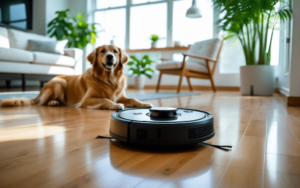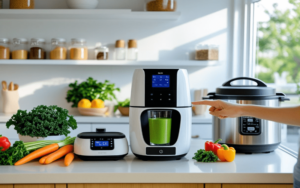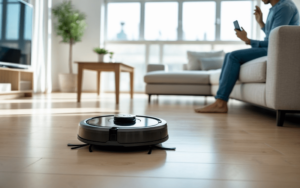Smart home technology can help people save energy, lower utility bills, and make daily life easier while protecting the environment.
Many eco-friendly upgrades, such as smart thermostats, LED lighting, and efficient power strips, cut down on waste by automatically managing how and when electricity is used at home.
People looking for practical ways to make their homes greener can start with automated lighting, climate control, and energy-saving outlets.
These tools work together so that lights, temperature, and appliances run only when needed.
Smart home upgrades don’t just help the environment—they can also boost comfort and convenience.
By choosing energy-efficient options and using technology wisely, anyone can take steps toward a more sustainable home.
Please note that this article contains affiliate links. We may earn from qualifying purchases at no extra cost to you.
Benefits of Eco-Friendly Smart Home Upgrades
Eco-friendly smart home upgrades can help lower utility bills, save natural resources, and create a healthier place to live.
These changes use new technology and smart controls to make homes more efficient and comfortable.
Energy Efficiency Improvements
Smart thermostats and lighting controls can reduce energy waste by only using power when needed.
For example, smart thermostats adjust heating and cooling based on who is home, saving energy when rooms are empty.
Smart lighting turns off lights automatically in empty areas and uses energy-saving bulbs to further decrease electricity use.
Window sensors and automated blinds also help keep homes cool in summer and warm in winter.
By preventing heat loss or gain, these upgrades allow HVAC systems to work less, lowering energy bills.
According to some experts, smart home features such as these can lead to noticeable drops in energy costs.
Appliances with energy monitoring features show real-time usage, so homeowners can see which devices use the most power.
This information makes it easier to change habits and cut back on electricity use even more.
Enhanced Indoor Environmental Quality
Smart air quality monitors can track pollutants, humidity, and carbon dioxide levels indoors.
When poor air is detected, systems can automatically adjust ventilation or air purifiers to bring back clean, fresh air.
This helps to reduce allergens and asthma triggers, making the home safer for people with breathing issues.
Smart water leak sensors prevent mold by alerting homeowners to leaks or high moisture before major problems develop.
Window and shade automations allow for better daylight use and natural airflow, which helps keep indoor air clean.
Automated systems also help keep the temperature and humidity at healthy levels.
This type of control improves comfort and well-being in every room.
We may earn a small commission if you purchase through this link. Thank you for supporting our content!
Shop our top selection from Amazon here
Reduced Carbon Footprint
Using smart tech can help a home use less electricity, water, and gas.
By lowering energy demand, homes create less pollution and greenhouse gases.
For example, smart power strips reduce “phantom loads” from appliances left plugged in, and water-saving devices lower unnecessary water use.
Smart irrigation systems cut down on outdoor water waste by watering only when the soil is dry.
Homes with these upgrades often reduce their carbon footprint over time, putting out fewer emissions linked to global warming.
Installing several of these features can make a home more eco-friendly while also raising property value.
Choosing these upgrades can help the environment and may even encourage others in the neighborhood to make similar changes.
Smart Energy Management Systems
Smart energy systems help reduce wasted power, lower electricity bills, and create a more comfortable home.
Devices like programmable thermostats, automatic lighting, and energy tracking tools let users manage their energy use in real time.
Automated Thermostats
Automated thermostats learn daily routines and adjust heating or cooling without manual input.
This helps prevent energy waste when people are away from home.
Some models use motion sensors to figure out if rooms are empty.
Homeowners can set schedules or let the thermostat make smart adjustments.
Over time, these devices create patterns based on user preferences, leading to greater convenience and lower energy bills.
Many can also connect to other smart devices.
A major benefit is remote access.
People can control their home’s temperature using a smartphone app.
Smart thermostats often provide reports, showing how changes save energy.
Shop our top selection from Amazon here
Intelligent Lighting Controls
Smart lighting systems let users control lights from their phones, voice assistants, or with automatic schedules.
These systems use LEDs, which use less energy and last longer than regular bulbs.
Lights can turn off automatically when no one is in the room by using motion sensors.
Dimming features help reduce electricity use even when lights are on.
Users can set timers to turn on lights only when needed.
Custom schedules are helpful for busy families.
Some systems can also adjust brightness depending on the time of day or outside light.
Integrating lighting with other devices makes it easier to manage energy use across the home.
Learn more about smart light solutions.
Shop our top selection from Amazon here
Energy Consumption Monitoring
Smart homes often use energy monitoring tools that track how much power each device uses.
These monitors give clear data on appliances, electronics, and heating or cooling systems.
Many energy monitors display real-time stats on an app or online dashboard.
This information helps people spot which devices use the most energy and where they can cut back.
Some systems send alerts when energy use is unusually high.
By checking trends and reports, homeowners can set goals and track their progress over time.
This leads to better decisions and smarter energy habits.
These tools work well with other smart eco-friendly tech to build a greener home.
Shop our top selection from Amazon here
We may earn a small commission if you purchase through this link. Thank you for supporting our content!
Sustainable Power Solutions

Reducing reliance on fossil fuels can help lower utility bills and support a cleaner environment.
Smart homes can use a combination of solar panels, home batteries, and connections with the power grid to make the most of renewable energy.
Solar Panel Integration
Solar panels use sunlight to generate electricity for a home.
Installing rooftop panels can cut a home’s need for traditional power.
Many smart homes use solar to power appliances, lights, and even car chargers.
Modern systems offer efficient solar cells and monitoring apps.
Homeowners can track energy production, spot problems, and make changes for better efficiency.
Using solar also reduces carbon emissions by using the sun’s energy instead of gas or coal.
Solar panel costs have dropped, making them more affordable than ever.
Governments may also offer rebates and tax credits, which helps lower the installation price.
For a deeper look at benefits and tips, visit this guide to creating an eco-friendly smart home with solar.
Home Battery Storage
Home battery systems store extra solar energy for later use.
This energy can power a home after sunset or when the grid goes down.
Batteries help maintain a steady supply of power and reduce dependence on the electric grid.
Smart batteries connect with phone apps so users can check how much energy is stored at any time.
During blackouts or heavy storms, batteries serve as backup power.
Some battery systems can even send energy back to the grid when supply is high.
Battery choices include lithium-ion or newer designs that offer improved storage and safety.
Picking the right battery depends on home size, daily energy needs, and solar panel output.
Grid-Tied Renewable Energy Systems
Grid-tied systems link a home’s solar setup to the public power grid.
These systems let homeowners use solar when it’s available and buy electricity when it’s not.
When solar panels make more energy than the home needs, the excess is sent to the grid.
A key advantage is net metering, which can provide bill credits for the extra electricity shared with the grid.
This lowers monthly costs and supports the community’s power supply.
Smart home technology can automate when to draw from the grid or the home’s batteries.
To learn more about connecting your smart home to sustainable power, check this guide on sustainable smart home solutions.
Water Conservation Technologies
Water-saving technologies help homeowners use less water without giving up comfort or convenience.
These upgrades can lower utility bills and reduce the environmental impact of everyday routines.
Smart Irrigation Controllers
Smart irrigation controllers are designed to use water more efficiently when watering outdoor areas.
They rely on real-time weather data and soil moisture sensors to adjust watering schedules.
This means lawns and gardens get the water they need, but not more than necessary.
According to Farmstand App, smart irrigation controllers can use up to 30–50% less water compared to traditional timers.
These savings are possible because the system skips watering during rain or when the soil already has enough moisture.
Homeowners can control these systems from their smartphones.
Some models even track water usage and alert users to leaks or broken sprinkler heads.
Savings from these devices can help offset the cost of installation over time.
The technology also helps keep landscapes healthy by preventing both overwatering and underwatering.
Low-Flow Faucets and Showers
Low-flow faucets and showerheads are quick upgrades that can change water use almost overnight. They simply limit how much water comes through, but you’d hardly notice—the pressure still feels good.
These fixtures use less water per minute, so the savings add up fast. Many models have a WaterSense label, which means they meet solid efficiency standards.
They’re easy to install and usually don’t need any plumbing changes. Swapping in low-flow devices in the bathroom or kitchen helps cut water use without any real loss in performance.
On top of saving water, these fixtures can lower your water and energy bills. Heating less water means less gas or electricity, so there’s a double win there.
Honestly, these upgrades are affordable and reliable if you’re trying to make your home more eco-friendly. Here’s a guide on optimizing water usage if you’re curious.
Eco-Conscious Smart Home Appliances

Smart appliances make it easier to cut down on energy use and save a bit on your utility bills. Most newer models use less water and work more efficiently than the old stuff cluttering up basements everywhere.
ENERGY STAR Certified Devices
ENERGY STAR certified devices are built to use less electricity than standard appliances. You’ll find the label on things like smart thermostats, dishwashers, air purifiers, and lighting.
These models help lower monthly energy costs by adjusting their settings for better efficiency without you having to fuss with them. For example, a smart thermostat learns your schedule and dials back heating or cooling when you’re out.
ENERGY STAR lighting uses LED bulbs, which last way longer and use much less power than old-school bulbs. Adding these appliances is a pretty straightforward way to make your home both smarter and greener.
If you’re upgrading major appliances, picking ENERGY STAR models just makes sense for a more sustainable living environment.
Shop our top selection from Amazon here
Smart Washing Machines and Refrigerators
Smart washing machines use sensors to adjust water and cycle time based on the load’s size and how dirty things are. Scheduling, remote control, and energy-saving modes help you use less water and electricity.
Some machines even send alerts when a cycle finishes, so you don’t forget laundry and waste power. Modern smart refrigerators track temperature and humidity, giving you a bit more control over food storage.
Many offer fast-cooling or energy-saving modes to keep food fresh and use less electricity. Put these features together and you get real savings—and a smaller carbon footprint, too.
Check out some top-rated eco-friendly home appliances if you want to go deeper.
Healthy Indoor Environments
Smart homes can help keep indoor air cleaner and cut down on exposure to nasty particles. With the right tech, you can track air quality and tweak ventilation to keep your space safe and comfortable.
Smart Air Quality Monitors
Smart air quality monitors check for pollution, allergens, humidity, and carbon dioxide inside the house. Most give real-time updates through your phone or a home display.
If dust, VOCs, or chemicals spike, you’ll get a warning so you can act fast. Many models link with smart speakers or other devices, so the whole household knows what’s up.
Some monitors suggest simple fixes—like opening a window or running a fan—when air quality drops. Picking a monitor that tracks both particles and gases gives you a clearer picture of what’s in the air.
Features to look for:
| Feature | Benefit |
|---|---|
| Real-time monitoring | Immediate alerts for changes |
| Multi-sensor measurements | Tracks PM2.5, VOCs, CO2, and humidity |
| Smartphone integration | Easy data access and sharing |
Getting a decent smart air monitor can help you understand and manage what you’re actually breathing day to day.
Automated Ventilation Solutions
Automated ventilation systems use sensors and smart controls to manage airflow. They’ll turn on exhaust fans or adjust air exchange rates when indoor air quality drops.
These systems help clear out stale air and bring in fresh air pretty quickly. Some advanced solutions connect with other smart devices, so everything works together without you having to think about it.
If a smart air monitor senses high pollution, the ventilation system can kick in automatically until things improve. This keeps your air safer without much effort on your part.
Smart ventilation also helps cut energy loss by running only when needed. Features like programmable settings and integration with smart home technology give you more control over your indoor environment.
Environmentally Responsible Materials and Design
Picking eco-friendly materials is a big deal if you care about the environment. Homeowners can go for things like bamboo or cork flooring—way more sustainable than regular wood.
These materials are tough, grow back fast, and don’t put as much strain on natural resources. Using recycled metal and reclaimed wood cuts down on waste and saves energy during production.
Design matters, too. Open floor plans let in more natural light, so you don’t need as many lights on during the day.
Good insulation with eco-friendly materials like recycled denim or cellulose keeps the heat in and saves energy over time.
Common Eco-Friendly Materials Used in Smart Homes
| Material | Benefits |
|---|---|
| Bamboo | Renewable, strong, fast-growing |
| Cork | Sustainable, natural insulator |
| Recycled Metal | Reduces landfill waste |
| Reclaimed Wood | Lowers demand for new timber |
| Quartz | Durable, less energy to produce |
Low-VOC paints and finishes are key for indoor air quality. They give off fewer harmful chemicals, which is safer for everyone—pets included.
More designers are focusing on eco-design in smart homes, mixing eco-friendly materials with smart tech. It’s a move that helps save resources and supports real sustainability, even if it’s not always perfect.
Future Trends in Green Smart Home Technology
Smart homes seem to get more energy efficient every year. Automated thermostats and smart lighting lead the charge, trimming electricity use while keeping things comfy.
Many folks have switched to energy-efficient appliances. They save power and, honestly, who doesn’t want a lower bill?
Another big shift is how different systems are starting to work together. You can hook up solar panels, batteries, and smart gadgets so everything talks to each other and manages energy use for you.
With more people adding electric cars and home batteries, a central smart hub is turning into a must-have. It’s a little wild how quickly this is catching on.
Water conservation technology is picking up steam too. Smart irrigation and leak sensors use real-time data to cut back on waste.
These upgrades make homes more sustainable. Plus, they can shrink those utility bills.
Here’s a quick look at some emerging trends in green smart home tech:
| Trend | Benefit |
|---|---|
| Smart lighting | Lower energy use |
| Water leak sensors | Prevent water waste |
| Energy-efficient appliances | Save power, save money |
| Integrated smart systems | Better energy control |
| Solar panel connections | Clean, renewable power |
New features keep popping up. Some smart homes now check air quality indoors automatically.
Smart windows that change tint with the sunlight are helping cut cooling costs. If you’re thinking about eco-friendly upgrades, you might just lower your carbon footprint.
Shop our top selection from Amazon here
This article contains affiliate links, which means we may earn a commission if you purchase through our links, at no extra cost to you. As an Amazon Associate, we earn from qualifying purchases. Thank you for supporting our content!




